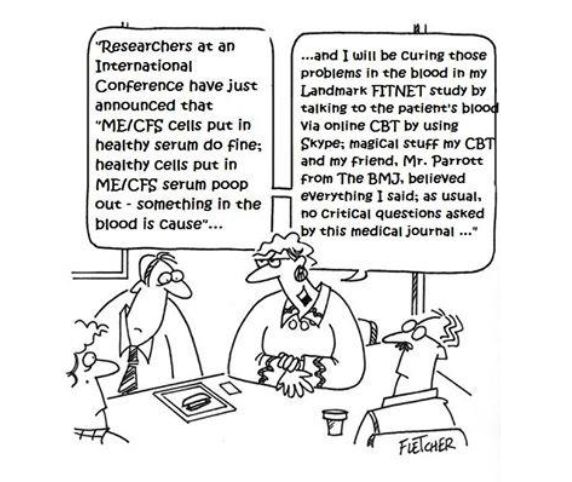me/cfs 27931
Guest
- Messages
- 1,294
This is beyond my knowledge level. But perhaps someone with the right background can comment on this article about an idea for testing and treatment for ME/CFS.
Is the era of precision medicine for chronic fatigue syndrome at hand?
https://luysii.wordpress.com/2017/0...edicine-for-chronic-fatigue-syndrome-at-hand/
September 4, 2017
If an idea of mine is correct, it is possible that some patients with chronic fatigue syndrome (CFS) can be treated with specific medications based on the results of a few blood tests. This is precision medicine at its finest. The data to test this idea has already been acquired, and nothing further needs to be done except to analyze it.
Athough the initial impetus for the idea happened only 3 months ago, there have been enough twists and turns that the best way explanation is by a timeline.
Infections of almost any sort are associated with fatigue, most probably caused by components of the inflammatory response. Anyone who’s gone through mononucleosis knows this. The long search for an infectious cause of chronic fatigue syndrome (CFS) has had its ups and downs — particularly downs — see https://luysii.wordpress.com/2011/0...irus-causing-chronic-fatigue-syndrome-in-lab/
At worst many people with these symptoms are written off as crazy; at best, diagnosed as depressed and given antidepressants. The fact that many of those given antidepressants feel better is far from conclusive, since most patients with chronic illnesses are somewhat depressed.
The 1 June 2017 Cell had a long and interesting review of cellular senescence by Norman Sharpless [ vol. 169 pp. 1000 – 1011 ].
One biochemical characteristic of the senescent cell is increased levels of a protein called p16^INK4a, which helps stop cellular proliferation. While p16^INK4a can easily be measured in tissue biopsies, tissue biopsies are inherently invasive. Fortunately, p16^INK4a can also be measured in circulating blood cells.
What caught my eye in the Cell paper was a reference to a paper about cancer [ Cancer Discov. vol. 7 pp. 165 – 176 ’17 ] by N. Demaria, in which the levels of p16^INK4a correlated with the degree of fatigue after chemotherapy. The more p16^INK4a in the blood cells the greater the fatigue.
If the results of the Cancer paper could be replicated, p16^INK4 would be the first objective measure of a patient’s individual sense of fatigue.
So I wrote both authors, suggesting that the p16^INK4a test be run on a collection of chronic fatigue syndrome (CFS) patients. Both authors replied quickly, but thought the problem would be acquiring patients. Demaria said that Sharpless had a lab all set up to do the test.
There matters stood until 22 August when a paper and an editorial about it came out [ Proc. Natl. Acad. Sci. vol. 114 pp. 8914 – 8916, E7150 – E7158 ’17 ]. The paper represented a tremendous amount of data (and work). The blood levels of 51 cytokines (measures of inflammation) and adipokines (hormones released by fat) were measured in both 192 patients with CFS (which can only be defined by symptoms) and 293 healthy controls matched for age and gender.
In this paper, levels of 17 of the 51 cytokines correlated with severity of CFS. This is a striking similarity with the way the p16^INK4 levels correlated with the degree of fatigue after chemotherapy). So I looked up the individual elements of the SASP (which can be found in Annu Rev Pathol. 21010; 5: 99–118.) There are 74 of them. I wondered how many of the 51 cytokines measured in the PNAS paper were in the SASP. This is trickier than it sounds as many cytokines have far more than one name. The bottom line is that 20 SASPs are in the 51 cytokines measured in the paper.
If the fatigue of CFS is due to senescent cells and the SASPs they release, then they should be over-represented in the 17 of the 51 cytokines correlating with symptom severity. Well they are; 9 out of the 17 are SASP. However although suggestive, this increase is not statistically significant (according to my consultants on Math Stack Exchange).
Suppose the idea turns out to be correct and that some patients with CFS are in fact that way because, for whatever reason, they have a lot of senescent cells releasing SASPs.
This would mean that it would be time to start trials of senolyic drugs which destroy senescent cells on the group with elevated SASPs. Fortunately, a few senolytics are currently inc linical use. This would be precision medicine at its finest.
Being able to alleviate the symptoms of CFS would be worthwhile in itself, but SASP levels could also be run on all sorts of conditions associated with fatigue, most notably infection. This might lead to symptomatic treatment at least.
Last edited:




